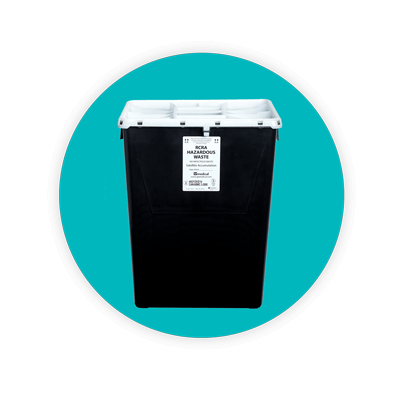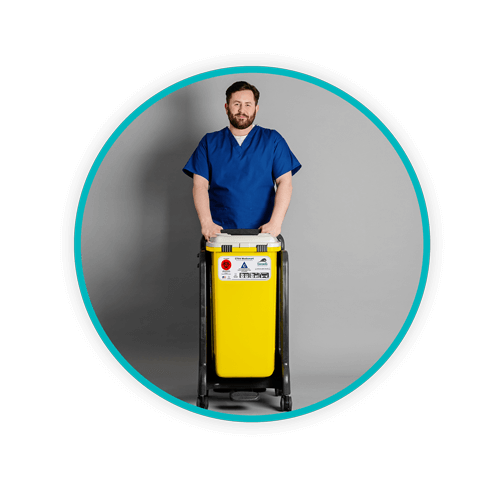How to Dispose of Chemotherapy Waste
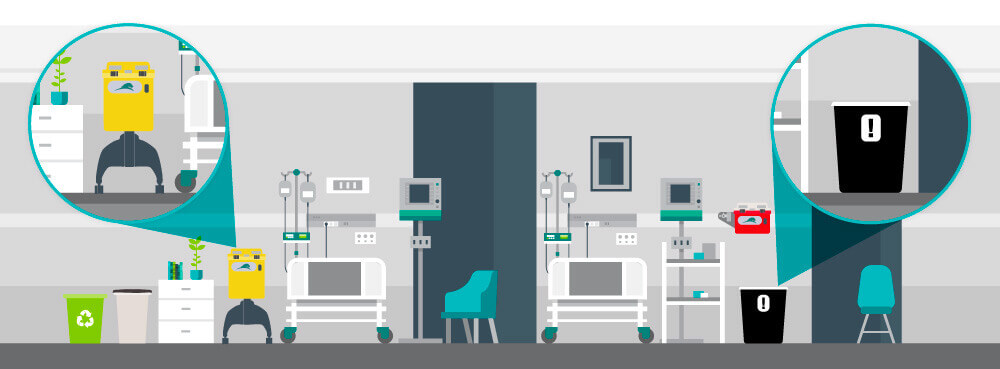
Disposing of chemotherapy waste requires a number of considerations. First comes the definition of chemotherapy waste. Is it just the drug? The bag filled with the chemo drugs? The IV tubing? Chemo waste is defined as either trace waste or bulk waste. What defines each?
A thorough understanding of terminology goes a long way toward maintaining compliance when it comes to chemotherapy waste disposal because there’s not just one waste stream – there’s two! And it’s up to the waste generator to understand how to segregate effectively between Trace Chemotherapy waste (yellow container) and Bulk Chemo RCRA hazardous waste (black container)
TOPICS WE WILL COVER:
1 /Know the Terminology Around Chemotherapy Waste Disposal
2 /What are Hazardous Waste Chemotherapy Drugs?
3 /State Guidelines Are More Stringent than Federal Guidelines
4 /Segregating Chemotherapy Waste
5 /Can I Dispose of Trace Chemotherapy and Bulk Chemotherapy Waste in the Same Container?
6 /Choose Daniels Health: the Industry Leader in Chemotherapy Waste Collection
Know the Terminology Around Chemotherapy Waste Disposal
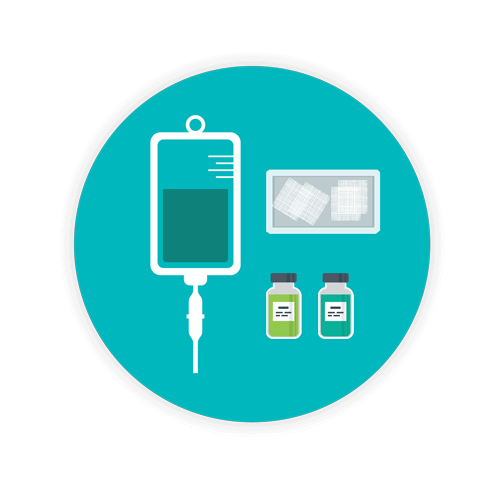
At its simplest definition, chemotherapy drugs that are listed as hazardous waste chemotherapy drugs must be segregated, managed and transported as hazardous waste rather than “just” medical waste.
Chemotherapy Waste Is Classified into What Two Groups?
Chemotherapy waste is categorized into two distinct groups based on its level of contamination:
Trace Chemotherapy Waste
This waste results from the preparation and administration of chemotherapy drugs and contains only minimal residual amounts of the drug or antineoplastic agent—therefore, it is “RCRA empty.” It includes items such as IV tubing, medicine bags, vials and any part of the delivery system that has come into contact with the drug.
Bulk Chemotherapy Waste
This includes materials that contain more than 3% of the original chemotherapy drug. It consists of partially full IV bags, syringes and items contaminated with a significant amount of chemotherapy agents which are therefore NOT “RCRA empty.”
Any items used to clean up a chemo spill are also deemed bulk chemo waste. Such waste must be stored in containers approved by the Department of Transportation (DOT) and correctly labeled as a hazardous pharmaceutical waste, as per DOT hazard classifications.
Chemotherapy Waste Belongs in What Color Container?
Trace chemotherapy waste must be disposed of in designated yellow chemotherapy waste containers, which are non-hazardous and intended for incineration. If the contents of the container are deemed “RCRA empty”—meaning only trace amounts (less than 3% residual) of the chemotherapy drug or antineoplastic agent are found on waste items (such as draping or gloves and tubing)—these items can be disposed of in the non-hazardous yellow trace chemotherapy container. Such regulations have been around for a while, per the EPA’s Introduction to Containers training document (40 CFR Parts; §261.7).
However, personal protective equipment (PPE), towels, wipes and pads may come into contact with chemotherapy drugs as well, and proper disposal is mandatory.
Bulk chemotherapy waste, on the other hand, is classified as hazardous and must be disposed of in a RCRA-rated container. Black containers are the industry standard but ultimately the color doesn’t matter.
What are Hazardous Waste Chemotherapy Drugs?
Wastes can be hazardous waste because of their characteristics (ignitability, corrosivity, reactivity and toxicity) or because they are specifically listed as hazardous waste. Nine chemotherapy drugs are listed or characteristic hazardous waste and each is assigned an EPA waste code. These include:
- Arsenic Trioxide
- Chlorambucil
- Cyclophosphamide
- Daunomycin
- Diethystilbestrol
- Melphalan
- Mitomycin C
- Streptozotocin
- Uracil Mustard
State Guidelines Are Often More Stringent than Federal Guidelines
Every state has its own chemotherapy waste disposal guidelines, but all regulations (federal, state, and local) must be followed. For example, New Hampshire’s management and disposal guidelines for U-listed antineoplastic (chemo) wastes provides explicit instructions on how chemotherapy waste is to be dealt with, in addition to following federal standards.,
Florida follows the guidelines of the RCRA regulations regarding the handling of hazardous waste (Title 40 CFR parts 260 through 271). The state also has its regulations, found in Florida’s Administrative Code, Rule 62 through 730.
In California, the department recommends segregating and managing non-RCRA hazardous waste from RCRA hazardous waste and disposing of only pharmaceutical waste that falls under California’s Title 42 §6901 in hazardous waste containers, including bulk chemotherapy drugs.
Why State-Specific Compliance Matters
Because states throughout the country employ different standards concerning the handling and disposal of chemotherapy waste, it is best to become familiar with the regulations of their locality and state, plus federal guidelines forward and backward. Some states mandate that all chemo waste be handled as a hazardous waste product and segregated from other types of waste. Others differ in both wording and requirements.
The medical waste business responsible for transporting that waste must also hold permits from the EPA for the proper management and disposal or treatment of that waste. Most states and localities also have mandatory regulatory guidelines for companies transporting and disposing of hazardous pharmaceutical waste and bulk chemo waste.
Note that it is the responsibility of the generator (i.e. hospital) to make sure that the medical waste disposal or medical waste pickup companies used by the facility are following regulatory guidelines. If they’re not, you also may bear the brunt of penalties and fines associated with noncompliance. It’s not just ethical—it’s the law.
Segregating Chemotherapy Waste
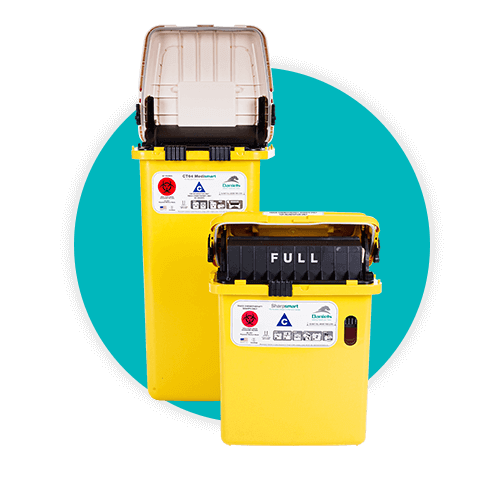 Special containers designed for chemotherapy waste can help the segregation process. For example: sharps used in chemotherapy administration. In such situations, not all sharps containers are meant to contain all sharps waste. Daniels Health makes it easier to segregate chemo waste from other waste streams with single use or reusable chemotherapy collectors and sharps containers in a variety of sizes. Some are designed for small quantity generators and small spaces. Some are disposable and others reusable. When it comes to different colored containers and tops to identify different waste streams. Our Chemosmart container comes with a yellow top and body to clearly identify it as a trace chemotherapy waste container and can be situated in a patient’s room, infusion bay or the chemotherapy treatment center. HOWEVER this is for Trace Chemotherapy waste… let’s dive into trace vs bulk.
Special containers designed for chemotherapy waste can help the segregation process. For example: sharps used in chemotherapy administration. In such situations, not all sharps containers are meant to contain all sharps waste. Daniels Health makes it easier to segregate chemo waste from other waste streams with single use or reusable chemotherapy collectors and sharps containers in a variety of sizes. Some are designed for small quantity generators and small spaces. Some are disposable and others reusable. When it comes to different colored containers and tops to identify different waste streams. Our Chemosmart container comes with a yellow top and body to clearly identify it as a trace chemotherapy waste container and can be situated in a patient’s room, infusion bay or the chemotherapy treatment center. HOWEVER this is for Trace Chemotherapy waste… let’s dive into trace vs bulk.
Can I Dispose of Trace Chemotherapy and Bulk Chemotherapy Waste in the Same Container?
Yes, you can; however, in this case it would all need to be “overcategorized” into a black hazardous waste bin. You cannot dispose of bulk chemotherapy waste (i.e., more than 3% of the residual drug) in a non-hazardous yellow chemotherapy waste container. Overcategorizing waste into a single black RCRA container for incineration will save time segregating the chemotherapy waste into two waste groups; however, it will have a few negative side-effects, including:
- A significant increase in costs. RCRA hazardous waste is at minimum three times the disposal cost of trace chemotherapy waste
- Negative Environmental Impact. All RCRA hazardous waste containers are disposable and incinerated, increasing plastic and environmental burden
- Reduced safety and staff protection. RCRA hazardous containers are not designed for a patient environment with safety, security or overfill mechanisms
Choose Daniels Health: the Industry Leader in Chemotherapy Waste Collection
Navigating chemotherapy waste disposal can be complex, especially when balancing patient care with regulatory compliance. At Daniels Health, we simplify the process by providing clear, differentiated Chemosmart container solutions, tailored placement strategies and comprehensive education to support healthcare facilities in managing both trace chemotherapy waste and RCRA hazardous waste, in full compliance with USP <800> standards.
Our fully integrated healthcare waste management program ensures standardization across all waste streams, from container selection to waste segregation and pickup schedules. By consolidating all waste streams under a single trusted partner, we help facilities optimize costs, minimize disruptions and uphold the highest standards of safety and sustainability—from waste collection to final disposal.
To learn how Daniels Health can enhance your chemotherapy waste management program, contact our team of specialists today.
Let's Talk!
Your time is valuable, and we don’t want to play hard to get. You can either phone us directly on the details listed on our contact page, or feel free to fill out this short form and one of our team members will get back to you as quickly as possible.
